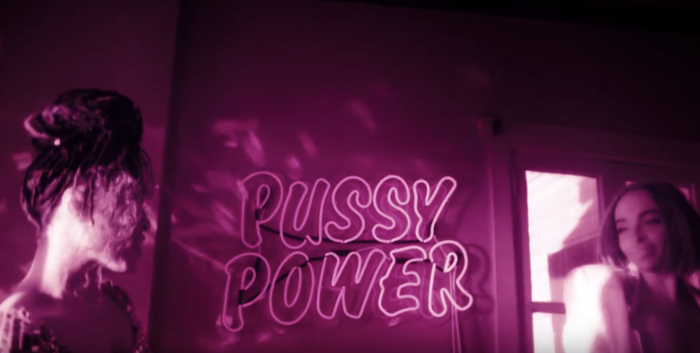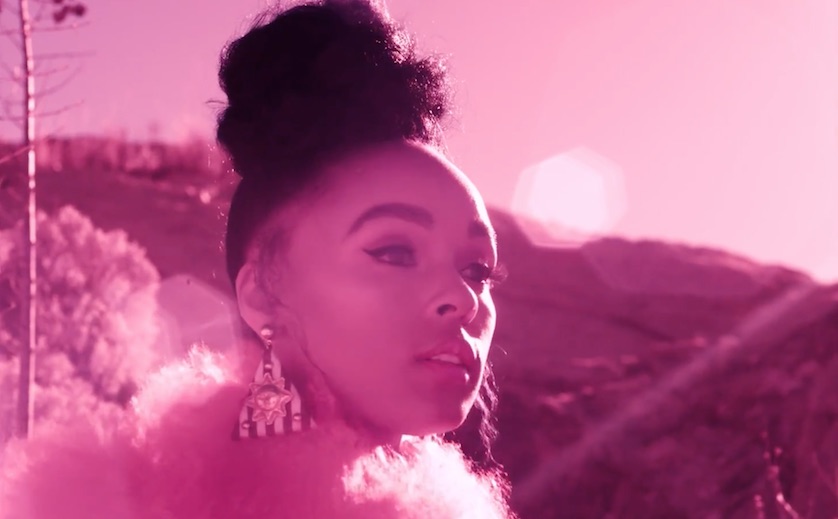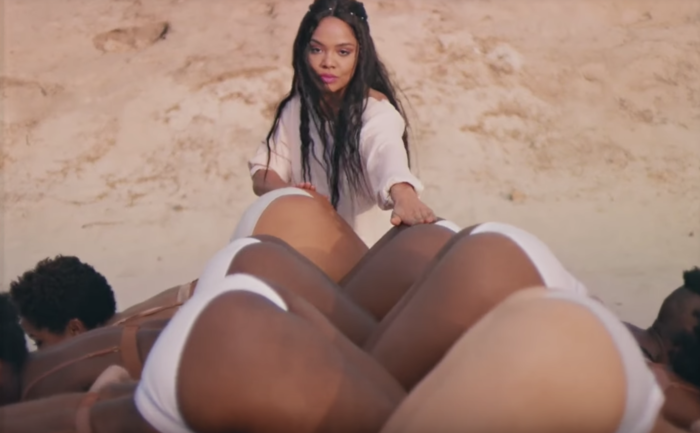
While the musical elements of “PYNK” are certainly important, the aesthetic of the video uses sexualized campy visuals and contrasting colors to comment on heterosexuality and gender in the 21st century. First and foremost, Monáe uses the name of the song, “PYNK,” for its association with the female gender, as well as for its association with humanity and the human body. In her lyrics, Monáe sings about pink as the color inside a baby, the color of a tongue and brain, the color as “the truth you can’t hide.” Using the color pink lyrically, Monáe “exhibits [the] feminine aspect of humanity,” reminding the listener that everyone, regardless of gender, sexuality, race, etc, is made up of the color pink (Gipson 2016, 93). While a rather obvious statement, it is important in the context of femininity and criticism of heterosexuality because the message being spread is one of community and inclusivity. The song is as much a criticism of modern conceptions of sexuality as it is an anthem of self love and individual identity (Florio 2018). Connected to “I Want To Break Free” and its use of drag to symbolize women wanting to break free from gender norms, “PYNK” uses the color pink to celebrate the “femaleness, freedom, and otherness through song,” that “I Want To Break Free” uses drag to represent (Gipson 2016, 95).

To emphasize these messages of community, love, and feminine power that the title and lyrics suggest, the video for “PYNK” is adorned with the color pink from beginning to end. Monáe applies a pink filter over several of the scenes of the video, and she uses the brightness of the color pink in her outfits as a juxtaposition to the relatively drab, simple background setting. The opening scenes of “PYNK” take place in the mountains, and the bland colors of the background make the color pink and the singer’s outfits pop in comparison. The contrast between Monáe and the mountains behind her help to keep the visuals simple enough so that the viewer does not become distracted, instead focusing on what Monae and the others in the video are doing.

Aside from the color alone as a representation of feminine sexuality and community, Monáe uses many different objects and campy outfits throughout the video that allude to certain sexual innuendos to reflect her own sexuality, as well as paint an image of black female sexuality. At one point, Monáe is shown standing in the mountains, wearing this campy, pink outfit and a bright fluffy scarf. The outfit has a very boxy shape and is decorated with gems that outline Monáe’s upper body. The pink filter covers the lense whenever she is shown in this outfit. She looks out of place, in the same way that the light colors against a dark background in “I Want To Break Free” make Mercury seem out of place in the setting. In terms of objects as sexual innuendos, in a news article titled “Here’s Every Vaginal Innuendo in Janelle Monae’s New Music Video ‘PYNK’,” the innuendos are listed, with some of the more notable ones being Monáe’s iconic “pussy pants” and several sexual shots of black women who make up the cast of the video (Gutowitz 2018). These innuendos are consistent with Monae’s attempt to use excessive campy visuals to reclaim her own sexuality as well as paint an image of black female sexuality.
One particularly important innuendo is displayed in the scene where several black women are lined up on their stomachs. In sync with the music, they raise their butts as the camera pans down the line. In the scene, the nudity comments on black female sexuality in a way that “situates their booties beyond satire in a more energizing expression that resists mere objectification” (Hobson 2018, 114). Additionally, the camera’s focus on their “booties” in a line doing a wave affirms that the women in this scene are in “control [of] their bodies…while simultaneously expressing their own sexual desire” (Andsager & Roe 2003, 86). This is important because Monae uses feminine nudity and desire to create a space where black female sexuality is celebrated rather than criticized. Combined with lyrics and visuals that use the color pink and “vagina innuendos” to create a community of women, the scene is really important because it normalizes black female sexuality by displaying black women engaging with each other in a sensual manner.
